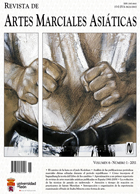A evolução das técnicas de pontapés no taekwondo
DOI:
https://doi.org/10.18002/rama.v6i1.87Palavras-chave:
Técnica, competição, regulamento, taekwondo primitivo, taekwondo moderno, karatéResumo
O propósito deste estudo é explicar a evolução das técnicas de pontapés do taekwondo e oferecer um marco histórico para esse processo. Este estudo analisa a primeira literatura sobre o karaté e o taekwondo, incluindo fontes coreanas diversas. Por outro lado, realizaram-se algumas entrevistas a pessoas relevantes do período investigado. O treino e as técnicas de karaté e do taekwondo foram muito similares até à década de 1960. Todavia, o taekwondo diferenciou-se das técnicas do karaté com a introdução das competições com contacto pleno durante essa década.Downloads
Métricas alternativas
Referências
An, Y. K. (1983). “Study for numbers used and scoring ability of each kick”. Tesis de Máster, Dongguk University [En coreano].
Art of Competition. (1987). Videocassette. Dirigido por J.B. Yang. Seoul: World Taekwondo Federation.
Capener, S. (1995). “Problems in the identity and philosophy of T’aegwondo and their historical causes”. Korea Journal, 35(4): 80–94, disponible en http://www.eagletkd.com/images/student%20forum%20from%20Korea% 0Journal.pdf.
Cho, S. H. (1968). Korean karate. Rutland & Tokyo: Charles E. Tuttle Company.
Choi, H. H. (1958). Taekwondo textbook. Seoul: Seong-Hwa-Mun-Hwa-Sa [En coreano].
Choi, H. H. (1965/1974). Taekwondo: The art of self-defence. Seoul: Daeha Publication Company.
Clayton, B. (2004). Shotokan’s secret: The hidden truth behind karate’s fighting origin. Valencia, CA: Black Belt Communications.
Funakoshi, G. (1957/1973). Karate-do kyohan: The master text. T. Oshima, (Trad.). Tokyo: Kondansha International. (Trabajo original publicado en 1935; revisado y reeditado en 1957 y 1973).
Funakoshi, G. (1925/1996). Rentan Goshin Tode-jutsu (Artes Toudi [karate]: refina tu valor para la defensa personal). Tokyo: Airyudo [En japonés].
Gillis, A. (2008). A killing art: The untold story of tae kwon do. Toronto: ECW Press
Hassell, R. (2007). Shotokan karate: Its history and evolution. Los Angeles: Empire Books.
Hwang, K. (1949). Hwasu-do textbook. Seoul: Cho-Sun-Mun-Hwa-Chul-Pan-Sa [En coreano].
Hwang, K. (1958). Tangsu-do textbook. Seoul: Gye-Rang-Mun-Hwa-Sa [En coreano].
Jeong, R. H., S. K. Lee, & H. J. Shin (1985). “Analysis of scoring and losing: Score variables by attack patterns in tae kwon do competition”. Journal of the Research Institute of Physical Education & Sports Science (Che-Yuk-KwaHak-Youn-Gu-So-Non-Mun-Jip), 4(1): 105-133 [En coreano].
Kang, W. S., & K. M. Lee (1999). A modern history of taekwondo. Seoul: BokYung-Moon-Hwa-Sa. (Partes disponibles en inglés en http://www.martialartsresource.com/anonftp/pub/the_dojang/digests/history.html.)
Kim, H. M. (1977). “A study of the influence of the slant kick in tae kwon do”. Tesis de Máster, Kyung Hee University [En coreano].
Kim, J. M. (2002). “A study on how the taekwondo games rules can [have] influence on the changes of game skills”. Tesis de Máster, Kyung Hee University [En coreano].
Kim, S. H. (1993). “The analysis of the frequency of attempts and the success ratio according to the attacking and Bal-no-rim patterns of taekwondo patterns”. Tesis de Máster, Inha University [En coreano].
Ko, E. M. (1980). Taekwondo wettkampf (Taekwondo competición). Munich: Schramm Sport [En alemán].
Koharu, I. (2000). [Investigación en los primeros años de kárate Ryukyu]. Tokyo: Airyudo [En japonés].
Lee, K. H. (1981). “A comparative study on [the] performance of the game in tae kweon do with the member[s] of the national team”. Tesis de Máster, Kyung Hee University [En coreano].
Lee, S. K. (1983). “Technical analysis of spinning kick [roundhouse kick] and study of scoring targets [areas]”. Tesis de Máster, Kyung Hee University [En coreano].
Lee, S. K. (1984). “Research analyzes of taekwondo game stepping patterns”. Keigan-Tae-Kwon-Do (Quarterly Taekwondo). 49: 106–15 [En coreano].
Madis, E. (2003). “The evolution of taekwondo from Japanese karate”. Martial Arts in the Modern World. Ed. T. Green & J. Svinth, 185–209. Santa Barbara, CA: ABC-CIO.
Motobu, C. (1929). Okinawa kenpo: Toudi jutsu kumite-hen (Kenpo de Okinawa: Karate-jutsu sobre kumite). Reimpresión en Koharu (2000).
Motobu, C. (1932). Watashi no karate jutsu (Mi arte del kárate). Reimpresión en Koharu (2000).
Nishiyama, H. & R. Brown (1960/1963). Karate: The art of “empty-hand” fighting. VT: Charles E. Tuttle Company.
Seo, S. W. (2007). Modern taekwondo history: The course. Seoul: Sang-A-GiHoek [in Korean].
Son, D. S. & R. Clark (1968). Korean karate: The art of tae kwon do. Englewood Cliffs, NJ: Prentice-Hall, Inc.
Sung, R. J. (1984). “Cinematographic analysis of jig eo cha gi in tae kwon do”. Tesis de Máster, Seoul National University [En coreano].
You, Y. K. (1980). “A study on the influence of counter-kicking to victory in tae kweon do”. Tesis de Máster, Kyung Hee University [En coreano].
Downloads
Publicado
Como Citar
Edição
Secção
Licença
Direitos de Autor (c) 2012 Udo Moenig

Este trabalho encontra-se publicado com a Licença Internacional Creative Commons Atribuição-NãoComercial-CompartilhaIgual 4.0.
Os autores que publicam nesta Revista estão de acordo com os seguintes termos:
- Os autores cedem, de forma exclusiva, os direitos de exploração (reprodução, distribuição, comunicação pública, transformação) à Universidade de Léon, podendo estabelecer, em separado, acordos adicionais para a distribuição não exclusiva da versão do artigo publicado na Revista (por exemplo: alojar no repertório institucional ou publicá-lo num livro), com o reconhecimento da publicação inicial nesta Revista.
- O trabalho encontra-se na Creative Commons Attribution-Non Commercial-Share Alike 4.0 International License. Pode-se consultar aqui o resumo e o texto legal da licença.
- Permite-se, e sugere-se, que os autores difundam electronicamente as versões pré-impressão (versão antes de ser avaliada) e pós-impressão (versão avaliada e aceite para publicação das suas obras antes da sua publicação), favorecendo a sua circulação e difusão, e com ela o possível aumento da sua citação e alcance pela comunidade académica.











